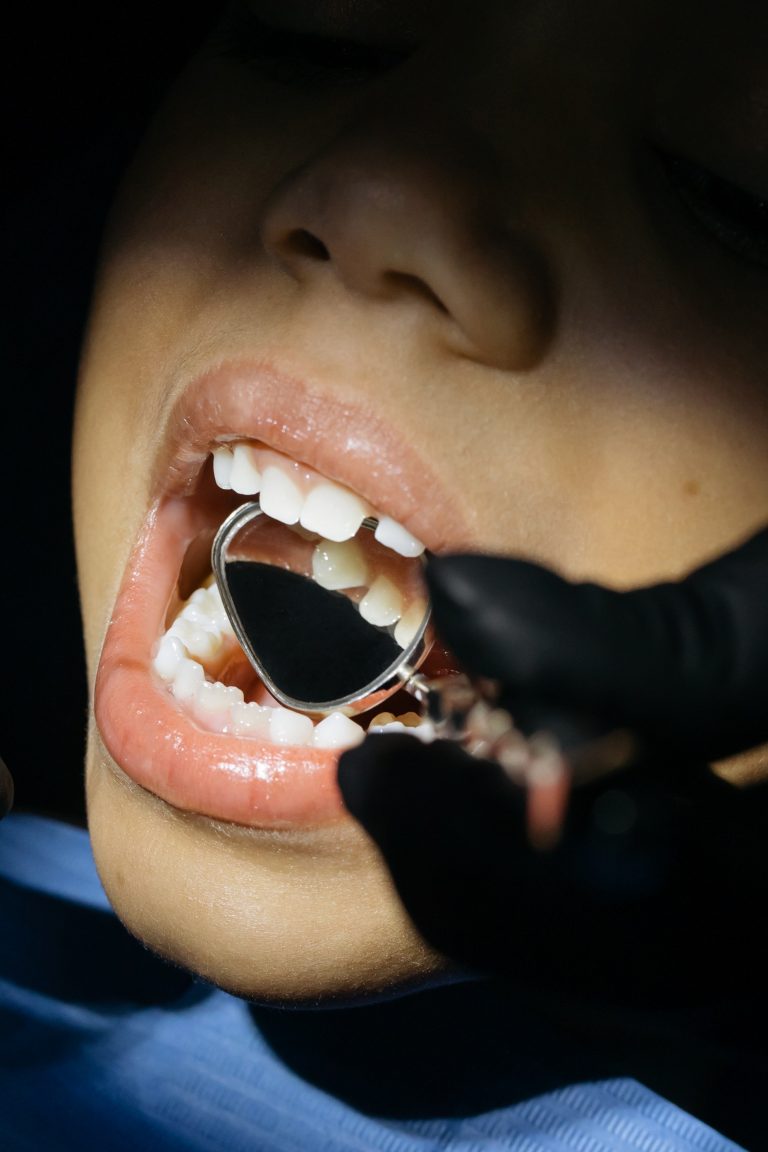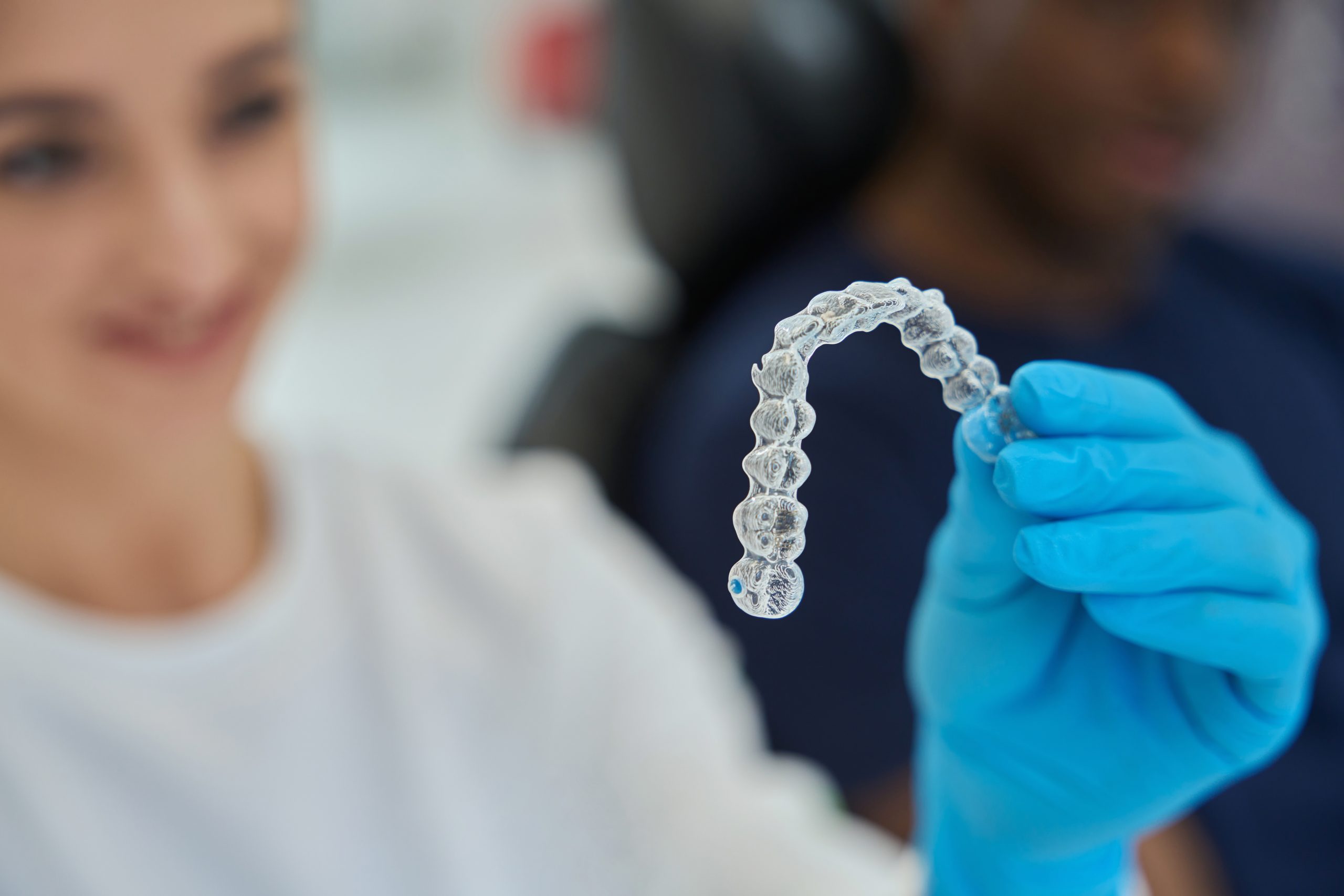What is an Orthodontic expander?
An orthodontic expander is an appliance that corrects your teeth and upper arch. Orthodontic expanders come either as fixed or removable appliances. The fixed option is called Rapid maxillary expander or RME and uses two bands cemented to your upper arch and last upper molars that are connected by a metal screw. The screw is turned regularly to expand and widen the appliance, that over time corrects your teeth alignment and expands the upper jaw.
What are the benefits of Expanders?
Expanders can help with Improved Sleep, Nasal Airflow, Airway Obstruction Alleviation, Crossbite Correction and Teeth Impaction to achieve that perfect smile.
1. Improved Sleep
Sleep apnea causes a reduction in oxygen and can affect the quality and amount of sleep you get. Sleep apnea can affect a sufferer in different ways. Sleep apnea is a medical diagnosis detected via a sleep test, known as a nocturnal polysomnography, by a sleep physician. During the tests, your heart, lungs, brain activity, body movements, and most notedly, your breathing patterns and oxygen levels are monitored while you sleep.
Can an RME help you? The short answer is yes. In fact, many studies (2) (8) (14) (15) regarding RME have displayed promising results in the treatment of airway resistance, pediatric sleep-disordered breathing, and obstructive sleep apnea and have demonstrated reduced negative pressure during ventilation. An expander can help widen the palate, open the airway, increase airflow, and make breathing easier. Allowing for that perfect sleep.
2. Nasal Airflow
An expander reduces congestion and airway resistance whilst increasing nasal airflow by widening the nasal cavity base. The reported benefits (6) to the upper airways include:
• The improvement of the respiratory pattern
• Improved allergic rhinitis
• The prevention of recurring sinus, nasal and ear infections
• Easing symptoms for asthma sufferers.
Before fitting an expander, your ears, nose, and throat need to be addressed by an Otolaryngologist (ENT). An ENT has special training in diagnosing conditions and diseases of the ear, nose, and throat. During your initial visit, your ENT will discuss your medical history and current symptoms. They will then perform a physical examination to inform you of your next steps. An ENT may suggest expanders to help alleviate symptoms. At Fox Orthodontics, we work with your ENT to help find a resolution and aid the improvement of your nasal airflow.
3. Airway Obstruction Alleviation
Expanders and RME therapy can also help alleviate sleep-disordered breathing by tensioning and stretching the palatine muscles and expanding the maxilla (16), widening the nasal fossae, releasing the septum, improving tongue structure and restoring normal nasal airflow (15)(4)(7).
Studies have shown that RME can be beneficial in the treatment of disorders such as Obstructive Sleep Apnea (OSA) (13) and have shown positive results in increasing nasal permeability whilst reducing airway resistance (17) (9). In addition, a larger palatal space can also improve tongue posture whilst facilitating increased airway space in the oropharynx (12).
Researchers have also found that RME therapy can effectively aid in reducing otitis media and conductive hearing loss due to the drainage of the Eustachian tubes when the tensor palatine muscles are stretched and the maxilla is expanded (16).
That is a big mouthful of studies to get your teeth into. But what does this mean for you?
RME can alleviate sleep apnea symptoms, increase space in your mouth and position your tongue, muscles and mouth correctly in place, helping you breathe better. What a breath of fresh air.

4. Crossbite Correction
Crossbite is when your upper jaw and lower teeth do not fit correctly, where your back top teeth will align and bite on the inside of your lower teeth as opposed to the outside.
A palate expander help alleviate unilateral and bilateral crossbite by widening the upper jaw and correcting your teeth to how they are supposed to align.
5. Teeth Impaction
A palate expander helps lessen teeth impaction and crowding by putting pressure on the premolars and upper molars and expanding the upper jaw every time the expander screw is adjusted. By widening the jaw, the expander allows more space for new permanent teeth. Creating more space and preventing or alleviating teeth impaction helps prevent the need for correctional work, repair, or teeth extraction down the line.

What is the purpose of an expander?
A palate expander helps lessen teeth impaction and crowding by putting pressure on the premolars and upper molars and expanding the upper jaw every time the expander screw is adjusted. By widening the jaw, the expander allows more space for new permanent teeth. Creating more space and preventing or alleviating teeth impaction helps prevent the need for correctional work, repair, or teeth extraction down the line.
Expanders help with Crossbite Correction and Teeth Impaction prevention by widening the upper teeth and jaw and gently separating the bones, allowing your top and bottom teeth to fit perfectly together, achieving that perfect smile.
Speak to our specialist Orthodontist for personalized orthodontic treatments today

What is the purpose of an expander for a child?
The purpose of an expander for a child is to make room by gradually widening the child’s palate and jaw, allowing their adult teeth to grow normally without misalignment. They are custom-made to fit your child’s palate.
Expanders help a child when there is not enough space for their permanent teeth due to a crossbite between their two mouth arches. We recommend starting early as expanders are most effective in children and preteens as their bones are still growing. Between this period, a child’s adult teeth and molars have come through.
For more help and alternatives to expanders for children, check out our Braces for Kids: An Orthodontists Guide.
Do expanders widen the nose?
No, an expander does necessarily visibly widen the nose but does widen the nasal dimension, and reports indicate maxillary expansion is associated with an increased nasal width, cross-sectional area and volume (5)(3)(11). RME also increases nasal permeability and enlarges the palatal space, reducing airway resistance and helping to increase airway space.
As a result, subjective improvement in nasal breathing has been noted in many studies (17) (9) that have found that expanders have a positive effect on the nose by widening the nasal cavity and reducing nasal airflow resistance.
How fast do expanders work?
Expanders usually take around 3 – 6 weeks to work and typically remain in the mouth for 6 – 9 months to allow the newly formed bone to mature.
Can you use an upper RPE with a lower expander?
Yes, lower expanders can be used in conjunction to accompany an upper RPE.
What is a lower orthodontic expander?
A lower orthodontic expander helps move and tip the lower teeth into an upright position to improve their positioning within the mouth, which can alleviate crowding. A lower orthodontic expander does not widen the bone like an upper orthodontic expander. Lower orthodontic expanders are rarely used and are often very uncomfortable, and there are other means by which you can widen the lower arch dimensions. Alternative lower arch-widening methods include fixed appliances using braces and wires.
At Fox Orthodontics, we do not use a lower expander. Our friendly team aim to provide the best specialist orthodontic treatment and solutions for you and will always look to deliver an experience with your comfort in mind. We do not suggest any treatment we feel is unnecessarily uncomfortable.
Speak to our specialist Orthodontist for personalized orthodontic treatments today.
We are a family-run practice established over 35 years ago. We have been straightening smiles for many years and continue to provide specialist orthodontic treatment to our patients. Our orthodontics clinic is conveniently located in Baulkham Hills. We also offer specialist orthodontics to Norwest, Hills District, Castle Hill, Parramatta, Kellyville, The Ponds and Blacktown.
Start your journey to a new smile with FOX Orthodontics.
Flexible, Interest-Free Payment Plans
References
1. Behrents RG, Shelgikar AV, Conley RS, Flores-Mir C, Hans M, Levine M, McNamara JA, Palomo JM, Pliska B, Stockstill JW, Wise J, Murphy S, Nagel NJ, Hittner J. Obstructive sleep apnea and orthodontics: An American Association of Orthodontists White Paper. Am J Orthod Dentofacial Orthop. 2019 Jul;156(1):13-28.e1. doi: 10.1016/j.ajodo.2019.04.009. PMID: 31256826.
2. Buck LM, Dalci O, Darendeliler MA, Papageorgiou SN, Papadopoulou AK. Volumetric upper airway changes after rapid maxillary expansion: a systematic review and meta-analysis. Eur J Orthod. 2017 Oct 1;39(5):463-473. doi: 10.1093/ejo/cjw048. PMID: 27440774.
3. Cappellette M Jr, Cruz OL, Carlini D, Weckx LL, Pignatari SS. Evaluation of nasal capacity before and after rapid maxillary expansion. Am J Rhinol. 2008 Jan-Feb;22(1):74-7. doi: 10.2500/ajr.2008.22.3130. PMID: 18284863.
4. Cistulli PA, Palmisano RG, Poole MD. Treatment of obstructive sleep apnea syndrome by rapid maxillary expansion. Sleep. 1998 Dec 15;21(8):831-5. doi: 10.1093/sleep/21.8.831. PMID: 9871945.
5. Derichsweiler, H. The disjunction of the midpalatal suture. Transactions of the European Orthodontic Society, 1953 (29), 257–265.
6. Gray, L.P. (1987) Rapid maxillary expansion and impaired nasal respiration. Ear, Nose, and Throat Journal, 66, 248–251.
7. Guilleminault C, Monteyrol PJ, Huynh NT, Pirelli P, Quo S, Li K. Adeno-tonsillectomy and rapid maxillary distraction in pre-pubertal children, a pilot study. Sleep Breath. 2011 May;15(2):173-7. doi: 10.1007/s11325-010-0419-3. Epub 2010 Sep 17. PMID: 20848317.
8. Hartgerink DV, Vig PS, Abbott DW. The effect of rapid maxillary expansion on nasal airway resistance. Am J Orthod Dentofacial Orthop. 1987 Nov;92(5):381-9. doi: 10.1016/0889-5406(87)90258-7. PMID: 2445196.
9. Hartgerink DV, Vig PS, Abbott DW. The effect of rapid maxillary expansion on nasal airway resistance. Am J Orthod Dentofacial Orthop. 1987 Nov;92(5):381-9. doi: 10.1016/0889-5406(87)90258-7. PMID: 2445196.
10. Kanomi R, Deguchi T, Kakuno E, Takano-Yamamoto T, Roberts WE. CBCT of skeletal changes following rapid maxillary expansion to increase arch-length with a development-dependent bonded or banded appliance. Angle Orthod. 2013 Sep;83(5):851-7. doi: 10.2319/082012-669.1. Epub 2013 Mar 14. PMID: 23488528; PMCID: PMC8744536.
11. Kanomi R, Deguchi T, Kakuno E, Takano-Yamamoto T, Roberts WE. CBCT of skeletal changes following rapid maxillary expansion to increase arch-length with a development-dependent bonded or banded appliance. Angle Orthod. 2013 Sep;83(5):851-7. doi: 10.2319/082012-669.1. Epub 2013 Mar 14. PMID: 23488528; PMCID: PMC8744536.
12. Koudstaal MJ, Poort LJ, van der Wal KG, Wolvius EB, Prahl-Andersen B, Schulten AJ. Surgically assisted rapid maxillary expansion (SARME): a review of the literature. Int J Oral Maxillofac Surg. 2005 Oct;34(7):709-14. doi: 10.1016/j.ijom.2005.04.025. PMID: 15961279.
13. McNamara JA Jr, Lione R, Franchi L, Angelieri F, Cevidanes LH, Darendeliler MA, Cozza P. The role of rapid maxillary expansion in the promotion of oral and general health. Prog Orthod. 2015;16:33. doi: 10.1186/s40510-015-0105-x. Epub 2015 Oct 7. PMID: 26446931; PMCID: PMC4596248.
14. Pirelli P, Saponara M, Attanasio G. Obstructive Sleep Apnoea Syndrome (OSAS) and rhino-tubaric disfunction in children: therapeutic effects of RME therapy. Prog Orthod. 2005;6(1):48-61. English, Italian. PMID: 15891784.
15. Pirelli P, Saponara M, Guilleminault C. Rapid maxillary expansion in children with obstructive sleep apnea syndrome. Sleep. 2004 Jun 15;27(4):761-6. doi: 10.1093/sleep/27.4.761. PMID: 15283012.
16. Taşpinar F, Uçüncü H, Bishara SE. Rapid maxillary expansion and conductive hearing loss. Angle Orthod. 2003 Dec;73(6):669-73. doi: 10.1043/0003-3219(2003)073<0669:RMEACH>2.0.CO;2. PMID: 14719731.
17. White BC, Woodside DG, Cole P. The effect of rapid maxillary expansion on nasal airway resistance. J Otolaryngol. 1989 Jun;18(4):137-43. PMID: 2472491.








